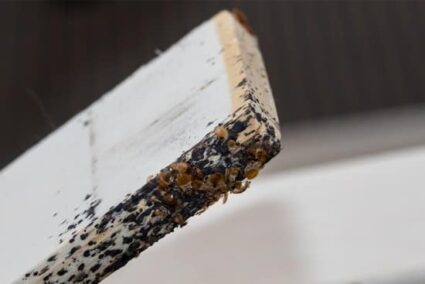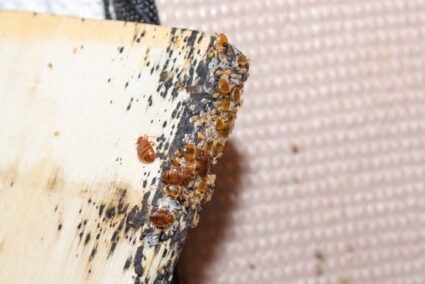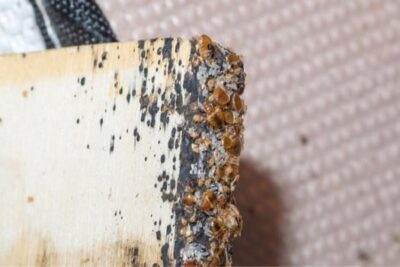Bed bug nymphs are a sign of a growing and active infestation. They indicate that the females are laying eggs, and that they must be feeding. Learning how to identify bed bug nymphs is vital.
Nymphs are the size of a grain of rice and flat. They are white and have a soft shell, so they are easy to squash. There are five instars/bed bug nymph stages, each of which is bigger than the last. The biggest is the size of an adult, i.e. an apple seed and brown. They bite, but don’t reproduce or lay eggs.
Once you learn what bed bugs look like, you can easily identify nymphs. Some people mistakenly believe that bed bugs aren’t visible to the naked eye, but that’s not the case.
What Do Baby Bed Bugs Look Like?
Baby bed bugs look similar to adult bed bugs, at least in terms of their body shape. They don’t go through the process of metamorphosis like other bugs do.
However, there are key differences, like their size. You can use these differences to identify an immature bed bug from a mature one.
What Size Are Baby Bed Bugs?
Nymphs are bed bugs that have recently hatched. They are much smaller than adults at around the size of a grain of rice. They are difficult to spot because of their size and color. That’s especially the case if you have white sheets and bedding.
However, you also have to account for larger baby bed bugs. There are five juvenile bed bug stages. The first two or three are arguably their ‘baby’ stage, as the bed bugs are much smaller. They also still are a different color.
These stages are progressively bigger. Second stage instars are a third of the size of an adult from head to abdomen. They are a third of the width, too. Third stage instars are half the size of an adult, both from side to side and head to end.
So, the smaller bed bugs are nymphs and the larger ones are fully grown.
What Color Are Baby Bed Bugs?
One central difference is the color of baby bed bugs. They are a white to an off-white color, the same as bed bug eggs. This is the color they are immediately after they hatch, and before they feed for the first time.
When they feed, that’s when their color starts to change. You will notice that they have a red lump in their abdomen, which is where they store your blood after feeding. They digest this food before shedding and growing larger.
As they digest and grow to the next stage, they begin to turn brown instead of white. This is a result of them using the nutrients from your blood. Each stage from the first to the fifth instar is browner and browner.
This continues until they are an adult. Adults are brown all over from consistent feeding. They never change color again once they reach this stage. So, a brown bed bug is an adult or late-instar bed bug. A white bed bug is a nymph.
Do Baby Bed Bugs Crawl Fast?
Bed bugs are not fast movers. They don’t crawl as quickly as other household pests, like cockroaches. There are three main reasons why:
- Don’t need to crawl fast. They rely on hiding rather than having to escape.
- Short legs. Their bodies are big while their legs are short and stubby.
- Don’t usually travel at full speed. If they’re disturbed, that’s when they move as fast as they can, to get away from danger. But even then they aren’t that fast.
Baby bed bugs are even slower than their fully-grown counterparts. That’s because they are smaller, so their legs are shorter. Rather than escaping trouble, they try to stay out of it by staying hidden. They only come out to feed, and only then at night.
So, if you notice a small bed bug moving slowly, it’s likely a baby.

Are Baby Bed Bugs Flat?
Baby bed bugs have a generally flat body shape. However, they are perhaps slightly less flat than adults. This is because they have yet to grow to their full adult size and shape.
Bed bugs have a flat body shape so that they can fit into narrow cracks. They are so flat that they used to have wings, but evolved to get rid of them. You can still see the tiny stumps where their wings used to attach to muscles in their back.
This is a trait shared by both adults and babies. However, one instance in which they are not flat is when they feed. When bed bugs feed, their abdomen expands. It becomes much larger than its original size. When this occurs, they aren’t flat.
While this is a difference you could observe through a microscope, you can’t use it in a real-world scenario.
Are Baby Bed Bugs Easy to Squish?
Baby bed bugs have a thinner exoskeleton than adults. Whether they have fed or not, they are easy to squash. This nevertheless is not an ideal bed bug treatment method. If you spot an individual bed bug, feel free to squash it. Squashing it will naturally kill it.
But if you rely on killing individual bed bugs, you will never catch them all. Bed bugs are good at hiding away in cracks and crevices. There will be some that you miss. You should pay a professional to kill bed bugs, either with pesticide or heat treatment.
Do Bed Bugs Shed Their Shells?
Bed bug juveniles shed their skins, while adults don’t. This process occurs when the bed bugs progress from one instar to another.
The bed bug will feed. This will give it the nutrients it needs to grow. As it begins digesting, it will also start to shed its shell. They do so because the shell would be too small for them if they didn’t.
These shell casings don’t rot or turn to dust. They are made from a substance called chitin, which is what all insects and crustaceans make their shells from. It’s solid, and while slightly flexible, not big enough for a growing bed bug.
These are a sign of a bed bug infestation. You may not spot the baby, but you can spot its casings.
Can Baby Bed Bugs Bite?
Baby bed bugs can bite, the same as adults. Juveniles have to feed on people or they would starve.
Bed bugs are a parasite. They need a host in order to live. Unlike other parasites, they don’t live inside or on their host. Instead, they live near their host in their bedding. From here they access you when you can’t prevent them, while you’re asleep.
But bed bugs are incapable of feeding on anything but blood. Their mouthparts are unlike other animals. They have a straw they drink through, and a tool they use to open holes in the skin. This applies both to juveniles and adults, meaning they eat nothing but blood their entire lives.
Feeding is essential for another reason. As bed bugs go from instar to instar, they can double in size and mass each time. To grow so much, so quickly, requires lots of nutrients. This means that they need to feed in order to grow.
Baby bed bugs begin to feed the moment they hatch. They grow larger each time they do.
What Do Baby Bed Bug Bites Look Like?
Baby bed bug bites look the same as adult bed bug bites. The cause of a bed bug bite’s swelling/redness is the body’s histamine reaction/allergic reaction.
This occurs because the bed bug uses saliva to numb the bite site. The body recognizes this as a foreign substance and swells up to aid in getting rid of it. The body’s reaction is the same as with an adult bite. These are as follows:
- The body directs more blood to the bite site, and more autoimmune cells, too.
- More blood in the area means that the bite site will swell.
- The body’s histamine reaction causes an uncomfortable itching.
And because the bite mark is created in the same way, baby bed bug bites last as long as those of adults. They will clear up over the course of two weeks. However, you will likely be bitten several more times in the meantime.
Are Baby Bed Bug Bites Smaller?
Baby bed bug bites aren’t noticeably smaller than the bites of adults. Babies use saliva to numb the bite site like adults do. This enables them to feed without you feeling it.
Despite being smaller than adults, baby bed bugs have to use as much saliva. If they didn’t, you would feel the bite in your sleep. You could then squash them or brush them off.
Because they use the same amount of saliva when they bite, their bites look and feel the same as those of adults.
If you notice that you have some small and some large bites, that’s normal. Bed bug bites vary in size for factors other than the age of the bug. Some are tiny, but some are as round as a large pea.

How to Find Baby Bed Bugs
According to the Center for Disease Control and Prevention, the majority of infestations occur in single-family dwellings. While they are common in hotels, they affect regular families the most.
Baby bed bugs aren’t easy to find. They are smaller than adults and lighter in color. But it isn’t an impossible task. If you want to search for baby bed bugs, follow these guidelines:
- Identify where they’re likely to be. Bed bugs live in groups in places called harborages. These are typically under your mattress, bed frame, or bedroom furniture.
- Pay close attention to certain areas. Cracks and seams are a bed bug’s favorite place to hide. They may also be in folded clothing, or behind the headboard of the bed.
- Use a magnifying glass. Babies are smaller, and are visible to the naked eye. But a magnifying glass would help you find them, and eggs too.
- Search for bed bug shells. Only juveniles shed their shells, because adults don’t grow. Shells are a sign of juveniles.
To be clear, it isn’t necessary for you to search for baby bed bugs. Even a solitary female can produce eggs if she has previously mated. This means that you can expect to find eggs and nymphs with a bed bug infestation of any size.
Found Baby Bed Bugs but No Adults
There is no such thing as baby bed bugs, but no adults. Baby bed bugs don’t travel: only adults do. There has to be at least one adult female laying eggs.
It is theoretically possible that the female laid the eggs and subsequently died. However, this is unlikely. It’s far more likely that the adult bed bug(s) have remained hidden.
Either way, your response should be the same. If you see baby bed bugs, that means the infestation is growing. When those babies reach adulthood, they will begin to lay eggs too. This can happen within a month. At this point, the infestation will grow exponentially.
You should begin treatment as soon as you spot any bed bugs, juvenile or otherwise. This will prevent the infestation from getting any bigger. You should act quickly because small infestations are far easier to kill than big ones.
Finding Baby Bed Bugs After Treatment
It is possible to find baby bed bugs after treatment. This can occur because some treatment methods don’t kill eggs. Pesticide can only kill bed bugs if they walk through it, which means that the bed bugs have to hatch first before it kills them.
If this occurs, don’t worry. Pesticides take several weeks to kill bed bugs. Throughout this time, you should expect to see many bed bugs, both nymphs, and adults.
If you still find baby bed bugs after heat treatment, that’s not a good sign. Heat treatment is supposed to kill all bed bugs immediately. This includes bed bug eggs, which cannot survive high temperatures.
When you do find baby bed bugs after heat treatment, notify your pest controller. They should fix the problem for you, given that they were supposed to fix it in the first place.
It may be the case that the bed bugs have re-infested your home from the walls or a neighbor. If this is the case, there is no easy solution. Continue trying to kill them until you can no longer find any bed bugs or their eggs.

